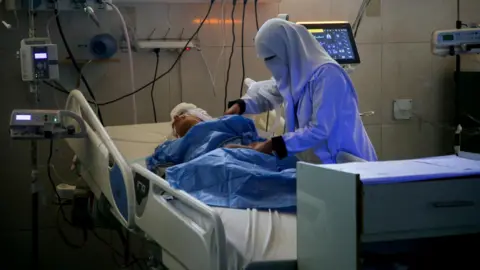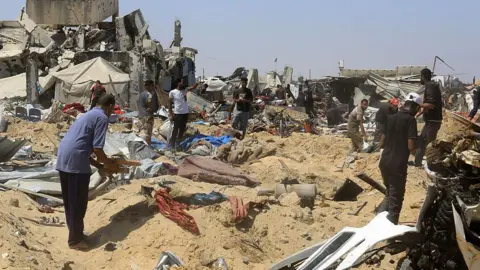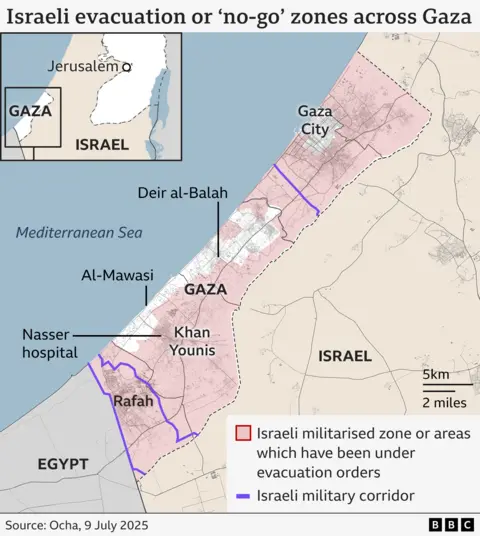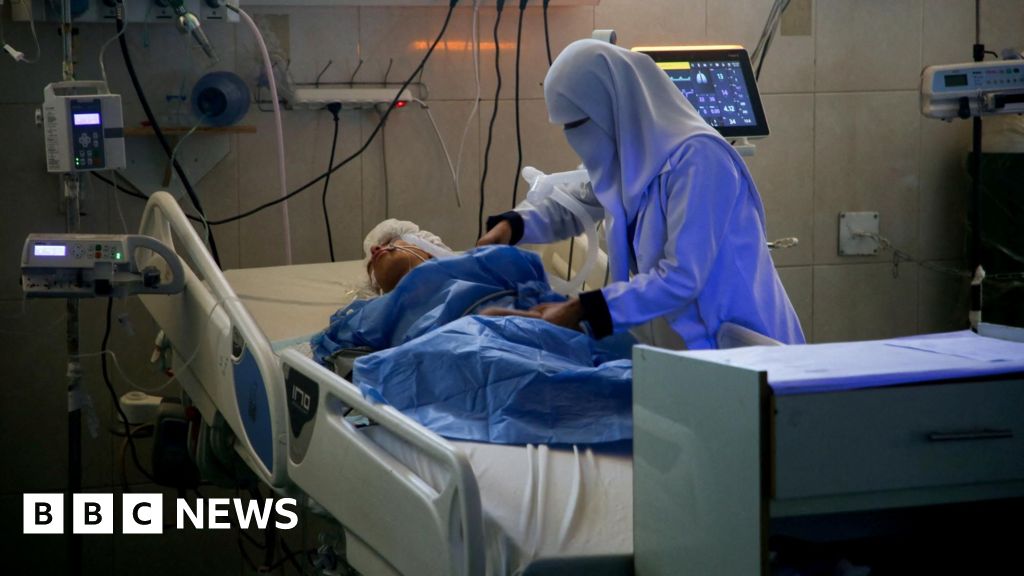 Reuters
ReutersDoctors have warned of an imminent disaster at Gaza’s largest functioning hospital because of critical shortage of fuel and a widening Israeli ground offensive in the southern city of Khan Younis.
Nasser Medical Complex was forced to stop admitting patients on Thursday, when witnesses said Israeli troops and tanks advanced into a cemetery 200m (660ft) away and fired towards nearby camps for displaced families. The forces reportedly withdrew on Friday after digging up several areas.
Medical staff and dozens of patients in intensive care remain inside the hospital, where the fuel shortage threatens to shut down life-saving services.
There was no immediate comment from the Israeli military.
However, it said on Friday morning that an armoured brigade was operating in Khan Younis to dismantle “terrorist infrastructure sites” and confiscate weapons> It has previously issued evacuation orders for the areas around the hospital.
A witness told the BBC that Israeli tanks accompanied by excavators and bulldozers advanced from the south of the cemetery near Nasser hospital on Thursday.
The tanks fired shells and bullets as they moved into an area, which was previously farmland, and several tents belonging to displaced families were set on fire, the witness said. Video footage shared online showed a plume of dark smoke rising from the area.
The witness added that Israeli quadcopter drones also fired towards tents in the Namsawi Towers and al-Mawasi areas to force residents to evacuate. Another video showed dozens of people running for cover amid as gunfire rang out.
One or two civilians standing near the hospital’s gates were reportedly injured by stray bullets.
Medical staff inside Nasser hospital meanwhile sent messages to local journalists expressing their fear. “We are still working in the hospital. The tanks are just metres away. We are closer to death than to life,” they wrote.
On Friday morning, locals said the Israeli tanks and troops pulled out of the cemetery and other areas close to the hospital.
Pictures shared online later in the day appeared to show deep trenches dug into the sandy ground, flattened buildings, burnt tents, and crushed vehicles piled on top of each other.
Staff at Nasser hospital said they were assessing if they could resume admitting patients.
 Anadolu via Getty Images
Anadolu via Getty ImagesOn Wednesday, they warned that the hospital was very close to a complete shutdown due to a critical fuel shortage.
They said electricity generators were expected to function for one additional day despite significant efforts to reduce power consumption and restrict electricity to only the most critical departments, including the intensive care and neonatal units.
If the power went out completely, dozens of patients, particularly those dependent of ventilators, would “be in immediate danger and face certain death”, the hospital added.
An Israeli military official told Reuters news agency on Thursday that around 160,000 litres of fuel destined for hospitals and other humanitarian facilities had entered Gaza since Wednesday, but that the fuel’s distribution around the territory was not the responsibility of the army.
There is a shortage of critical medical supplies, especially those related to trauma care.
During a visit to Nasser hospital last week, the Gaza representative of the World Health Organization (WHO) described it as “one massive trauma ward”.
Dr Rik Peeperkorn said in a video that the facility, which normally has a 350-bed capacity, was treating about 700 patients, and that exhausted staff were working 24 hours a day.
The director and doctors reported receiving hundreds of trauma cases over the past four weeks, the majority of them linked to incidents around aid distribution sites, he added.
“There’s many boys, young adolescents who are dying or getting the most serious injuries because they try to get some food for their families,” he said.
Among them were a 13-year-old boy who was shot in the head and is now tetraplegic, and a 21-year-old man who has a bullet lodged in his neck and is also tetraplegic.
On Friday, 10 people seeking aid were reportedly killed by Israeli military fire near an aid distribution site in the nearby southern city of Rafah. The Israel Defense Forces (IDF) has not commented.
 Reuters
ReutersMeanwhile, in northern Gaza, a senior Hamas commander was among eight people who were killed in an Israeli air strike on a school sheltering displaced families in Jabalia, a local source told the BBC.
Iyad Nasr, who led the Jabalia al-Nazla battalion, died alongside his family, including several children, and an aide when two missiles hit a classroom at Halima al-Saadia school, according to the source.
Another Hamas commander, Hassan Marii, and his aide were reportedly killed in a separate air strike on an apartment in al-Shati refugee camp, west of Gaza City.
It comes as Israeli Prime Minister Benjamin Netanyahu said that a new Gaza ceasefire and hostage release deal could be just days away, after concluding his four-day trip to the US.
Before flying back from Washington on Thursday night, he told Newsmax that the proposal would supposedly see Hamas release half of the 20 living hostages it is still holding and just over half of the 30 dead hostages during a 60-day truce.
“So, we’ll have 10 living left and about 12 deceased hostages [remaining], but I’ll get them out, too. I hope we can complete it in a few days,” he added.
However, a Palestinian official told the BBC that the indirect negotiations in Qatar were stalled, with sticking points including aid distribution and Israeli troop withdrawals.
The Israeli military launched a campaign in Gaza in response to the Hamas-led attack on southern Israel on 7 October 2023, in which about 1,200 people were killed and 251 others were taken hostage.
At least 57,762 people have been killed in Gaza since then, according to the territory’s Hamas-run health ministry.












